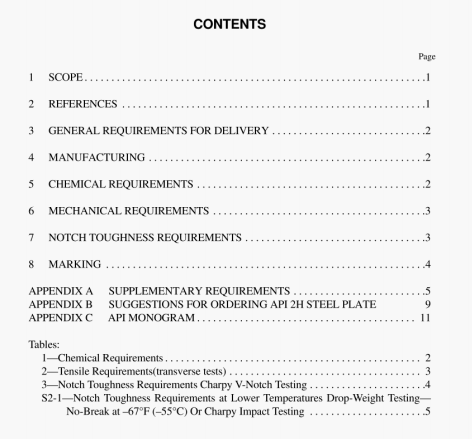API SPEC 2H:2007 pdf download.Specification for Carbon Manganese Steel Plate for Offshore Structures.
a. Prolongations shall be joined to opposite surfaces of the plate being tested, with their axes coincident. The joining method used should be one which results in a minimal heat-affected-zone in the portion of the coupon being tested. Friction (inertia), stud, electron beam, or shielded metal-arc welding methods have proven to be suitable. Prolongation materials shall be selected so that failure shall occur in the plate portion of the specimen.
b. Specimens shall be machined to the form and dimensions of the 0.5(X) in. (12.5 mm) round specimen of Figure 4 of ASTM A370. except for the plate thickness less than II4 in. (32 mm) where the 0.35() in. (8.75 mm) test specimen may be used.
c. The full plate thickness shall be contained within the uniform section with no taper permitted. The length (“G” in Figure 4 of ASTM A370) of the cylindrical section of the test piece shall be adjusted as necessary to contain the plate thickness within a uniform diameter throughout the section.
S4.6 1’xving. Tensile testing shall be conducted in accordance with the requirements of ASTM A370.
S4.7 Accepiunce Sanckrnb.. Standards for the acceptance of through-thickness testing shall be as follows:
a. Each tension test specimen shall exhibit a minimum reduction-of-area of 30%. If one of the two specimens from a plate is below 300/.. hut not below 25%. a retest of two additional specimens from a location adjacent to the failed specimen shall be made, and both of these additional determinations shall equal or exceed 30%.
b. Minimum reduction-of-area limits higher than stated in S4.7a may be specified subject to agreement between the material manufacturer and the purchaser.
S4.8 Marking. Plates accepted in accordance with this procedure for through-thickness testing shall be identified by stamping or stenciling “Z” adjacent to marking otherwise required (i.e.. API 2H-50Z).
S5 Low Sulfur Steel For Improved Through-Thickness Properties
S5.1 miens. The intent of this supplementary requirement is to provide, by chemical control, plates with low levels of sulfide inclusions and thereby a reduction of the potential for lamellar tearing of the plate in the area of attachment welds.
S5.2 Chemistry. The steels shall conform to the requirements for chemical composition prescribed in Table 4.1, except that the maximum content of sulfur on beat analysis shall be 0.(X)6%.
S5.3 Thrnugh-Thickne.s Te.siing. Through-thickness (Z-direction) tensile testing is not required by this supplementary requirement.
S5.4 Marking. Plates accepted in accordance with this supplementary requirement shall be identified by stamping “LS’ adjacent to marking otherwise required (i.e.. API 2HXLS). Note: “X” refers to “G”, “N”. or “QT’ as required by 8.l.c.
S7 Low Nitrogen Content For Improved Notch Toughness in Strain-Hardened Condition
S7.1 The nitrogen content shall be 0.(X$)% maximum on heat analysis,
S8 Strain-Aged Charpy V-Notch Impact Tests
S8.1 Charpy V-notch impact test coupons representing the thickest and thinnest plate of each heat shall he uniformly strained 5%. or more if specified, in axial tension and aged at 4K0°F (25OC) for one hour at temperature prior to cutting the test specimens. The test results obtained from these specimens shall meet the requirements of Section 7.
S12 Notch Toughness Using Drop Weight
Si 2.1 Drop-Weight tests shall be conducted. One plate per 50 ton (45 t) lot or part thereof of the plates in each heat /s inch (16 mm) or more in thickness shall be tested. The plate tested shall be the thickest gage in each 50 ton (45 t) lot.
API SPEC 2H:2007 pdf download
